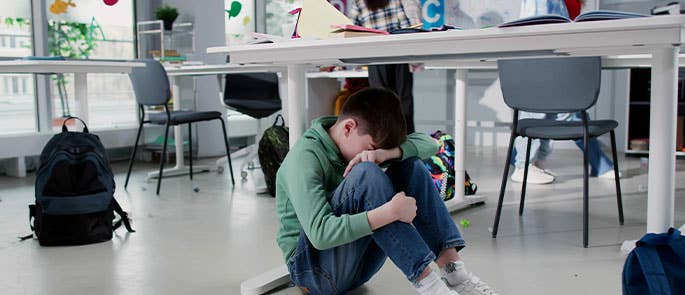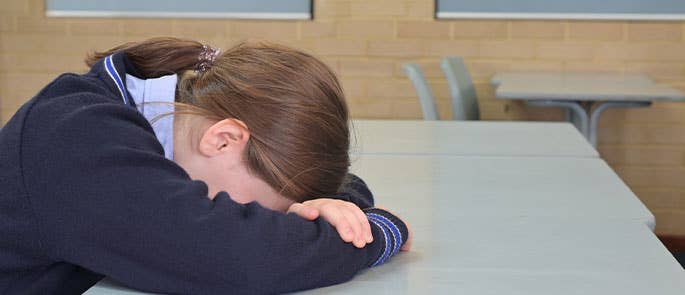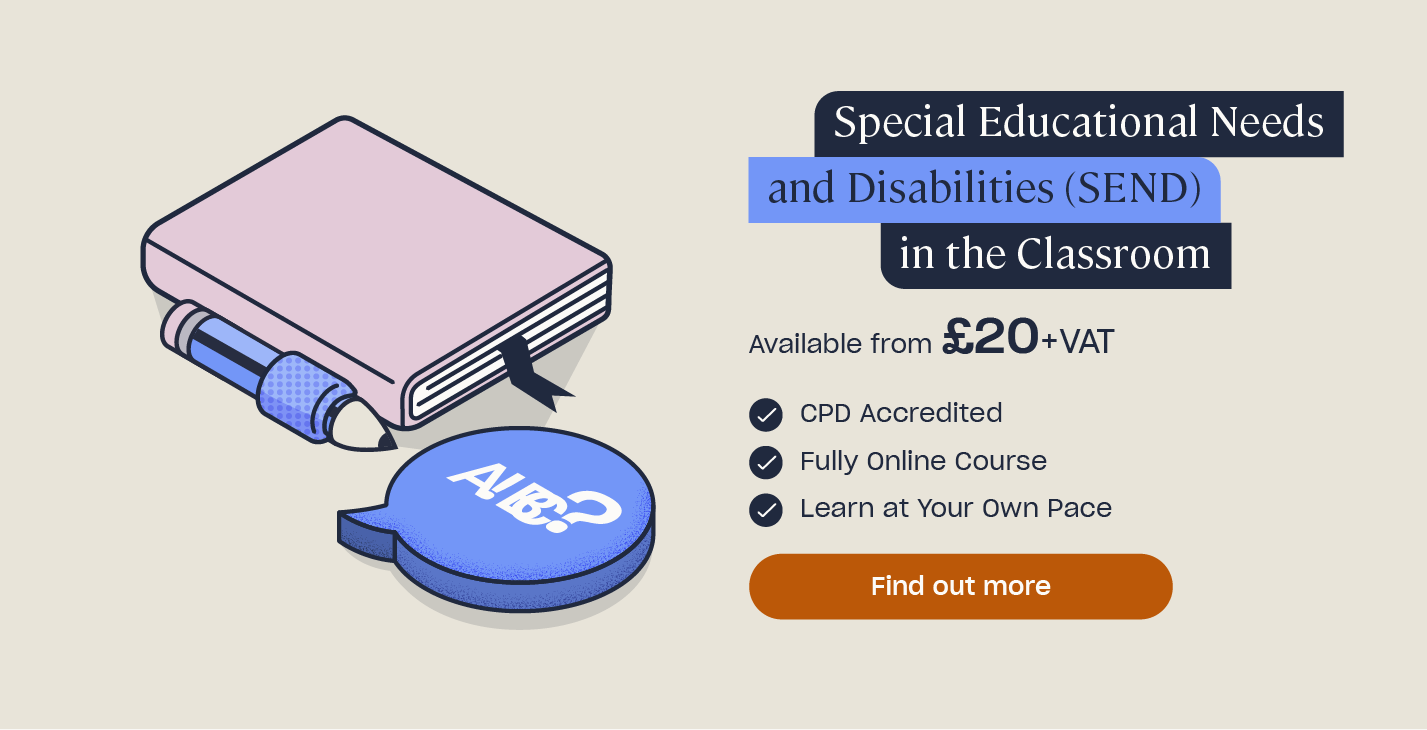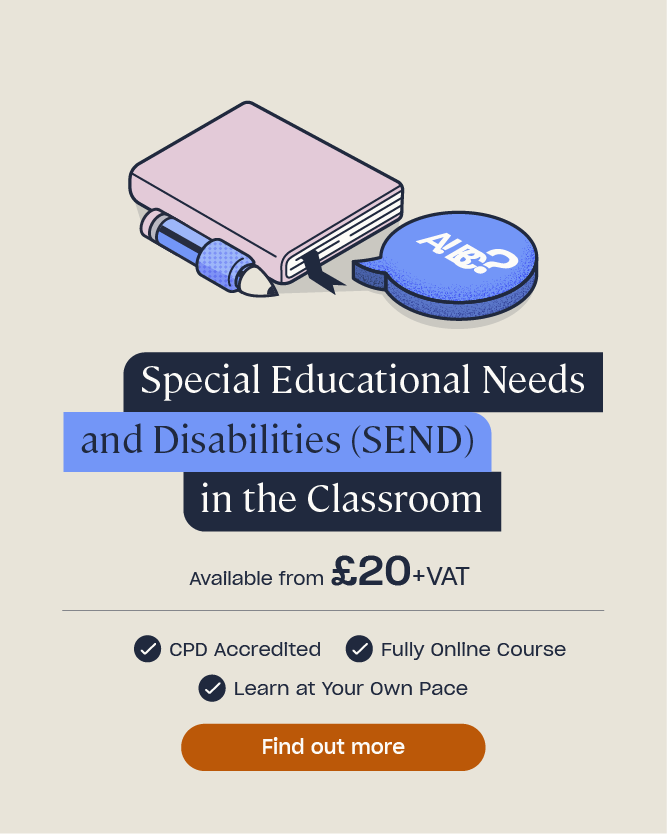Sensory Needs in the Classroom
For those who work in a classroom environment, and especially for those who work closely with SEND pupils, understanding the needs of individual students is important to ensure all children receive the care, attention and education they deserve. As a teacher, you may have pupils in your classroom with neurodiverse conditions, such as autism and ADHD, and therefore need to recognise the sensory issues that accompany them. In this article, we’ll look at what sensory needs are, identify some common sensory needs and provide you with some strategies for the classroom to help improve the teaching experience for everyone.

What are Sensory Needs?
A child has sensory needs when their brain has difficulty responding to the information it receives from one or more of their five senses – sight, sound, taste, touch and smell.
Sensory needs occur when something in the environment triggers the senses in a way that causes sensory overload or overstimulation, and the brain finds it difficult to process what is happening. If the brain receives too much sensory information – such as from a noisy, bright or smelly classroom – then the child with sensory needs may feel stressed or anxious, resulting in distressed behaviour or physical symptoms.
A child with sensory needs may display a physical or behavioural reaction to sensory overload because they find the situation hard to cope with, and reacting in a specific way helps them to feel better. For example, the child may kick and hit things or people, shout loudly or hum constantly, put things in their mouth, stare intently at things/or people, or retreat from the situation and not join in with everyone else.
Whilst these behaviours can be challenging for teachers and other pupils, remember that the child is not trying to be difficult or naughty, they are simply responding to the distress they are feeling.
The environment that the child is in affects the amount of sensory overload they experience, which is why it’s vital that sensory needs in the classroom are carefully considered. As a teacher, you have an important role to play in supporting children with sensory needs to ensure they achieve the best outcomes.

Sensory Needs in the Classroom
For children with sensory needs, the classroom environment can be a haven or a hell depending on how overwhelming it is for their senses. A supportive classroom makes being at school enjoyable and ensures children feel safe and calm – and will reduce the likelihood of challenging behaviour from all students, not just those with sensory needs.
If a child with sensory needs feel safe in their classroom, then they are empowered to learn and aren’t afraid to join in. If the child feels threatened by their learning environment, however, they are likely to struggle with areas such as:
- Taking in new information.
- Concentrating on schoolwork.
- Maintaining a ‘ready-to-learn’ attitude.
- Responding to requests from the teacher.
- Participating in social situations, such as in the playground.
- Joining in with sports and games.
For teachers, your aim should always be to recognise which children in your care have sensory needs and then look to alter the classroom environment where possible to make it less overwhelming for them. Consider what will help the child with sensory needs, what their individual triggers are and what behaviours they display that indicate they’re struggling. Every child with sensory needs is different and will have different stimulants and behaviours.
For advice on how to create a positive learning environment, take a look at our article here.
Want to Learn More?
If you work in education and have SEND or neurodiverse pupils in your care, then our Autism Awareness in Education Training and ADHD Training courses will help you develop your knowledge further, enabling you to better support the students that you work with.
Sensory Needs Autism
Autism is a developmental disability that causes children to experience and interact with the world differently to their non-autistic peers. It’s a type of neurodiversity and is often characterised by communication and language differences, social interaction differences, rigid and repetitive behaviours and particular sensory needs.
It’s estimated that 1 in 100 children have autism. If you have an autistic child in your class, then knowing how to support them is vital: our article on How to Support Autistic Children in the Classroom provides further information on this topic.
Some sensory needs that are often specific to a child with autism include:
- Difficulty looking at you and listening to what you’re saying at the same time.
- Finding classrooms to be visually overwhelming and distracting.
- Not wanting to stand close to other students due to issues with body awareness (proprioception).
- Struggling to walk down a noisy corridor, so needing to leave lessons before or after everyone else.
- Being over-sensitive to noises and hearing everything more loudly and clearly than they actually are or, alternatively, being under-sensitive and struggling to hear sounds and voices.
- Struggling with vision, such as depth perception, dark/light contrasts, having blurry vision or being unable to focus on details.
- Not liking being touched or finding certain textures uncomfortable.
- Having a high pain threshold and not recognising dangers.
- Finding smells overwhelming and intense, such as perfumes and paints.
- Struggling with balance and coordination, like when playing sports, dancing or doing games in the classroom.
- Needing to move their body frequently, such as rocking or spinning.
Sensory Needs ADHD
ADHD stands for Attention Deficit Hyperactivity Disorder and is another form of neurodiversity. It’s often characterised by behaviours such as impulsiveness, inattentiveness and hyperactivity, as well as hypersensitivity to sensory information.
Children with ADHD may find it difficult to sit still, follow instructions and concentrate in the classroom. Alternatively, they may feel restless rather than hyperactive. If you have a student with ADHD in your class, then our article on Managing ADHD in the Classroom will provide you with further information and support.
Some sensory needs that are often specific to a child with ADHD include:
- Finding schools to be visually over-stimulating and distracting, such as busy classroom wall displays.
- Having trouble ‘settling down’ after class activities.
- Being over-sensitive to strong smells, such as perfumes and paints.
- Finding certain textures uncomfortable, such as not liking the sensation of a velvet cushion or an itchy jumper.
- Struggling to self-regulate their emotions or reactions, resulting in sudden outbursts
- Finding transitions between activities difficult and struggling to maintain attention in the lull between tasks or classes.
- Not liking the feel of certain movements, like being on a swing.
- Avoiding foods with certain textures.
- Often feeling distracted or disorganised.

Sensory Strategies for the Classroom
For a child with sensory needs, the classroom needs to be an environment where they can focus and learn. Putting sensory support strategies in place in your classroom will help to increase or decrease the sensory input a child receives, depending on their particular triggers. Whilst the supports you choose to use should be tailored for each individual child with sensory needs, you’ll often find that the strategies and routines can often be beneficial for the whole class.
Here are 15 easy sensory strategies for the classroom that teachers and school staff can implement today:
- Use natural light where possible, as overhead lighting can be harsh and too bright.
- Reduce noise in the classroom by deadening the sound with rugs, carpets and soft furnishings.
- Give each student a mat or a chair so they know where to sit during lessons and activities.
- Play calming background music, such as classical music or children’s nursery rhymes, as this can aid concentration.
- Give noise-cancelling headphones to children who would benefit from them.
- Ensure the temperature of the classroom isn’t too warm or too cold, as both can cause stress or distraction.
- Choose fabrics and cushions that are soft, warm and comfortable, avoiding scratchy or itchy textures that may cause irritation.
- Introduce activities that encourage body awareness and muscle movement, such as obstacle courses, jumping onto crash mats and pushing/pulling objects.
- Use scented pens, paints and paper to help maintain children’s attention and increase interest and focus on a task.
- Use calming smells around the classroom, like lavender and rose, though be careful if you have children who are sensitive to scents.
- Introduce daily activities that involve lots of movement and singing, such as morning exercise, dancing, clapping or using instruments, for those who need physical stimulation.
- Use a privacy screen or dedicated desk for students who need to concentrate, without distractions, when working.
- Offer weighted blankets to children who need the comforting feeling of weight on their bodies.
- Allow children to choose what they sit on at story time, such as chairs, beanbags, cushions and mats, so they can pick the texture they like best and to encourage awareness of personal space.
- For children who are overwhelmed by changes or transitions, use pictures to show the day’s activities or take photos to inform the child about what’s happening next. Take a look at our Now and Next Board article for a free template.
Children with sensory needs deserve a supportive school environment that helps them feel calm and in control of their sensory triggers. As a teacher, you can support pupils with neurodiverse conditions by recognising which students have sensory needs, what their particular symptoms are and how you can put strategies in place in the classroom to improve their day-to-day school experience.
Further Resources:
- Special Educational Needs and Disabilities (SEND) in the Classroom
- How to Create a Behaviour Support Plan: Free Template
- What are Specific Learning Difficulties (SpLDs)?
- What is Neurodiversity & How Does it Relate to Autism?











